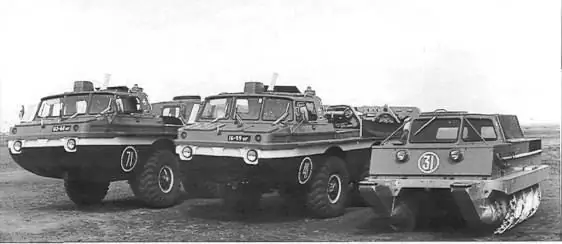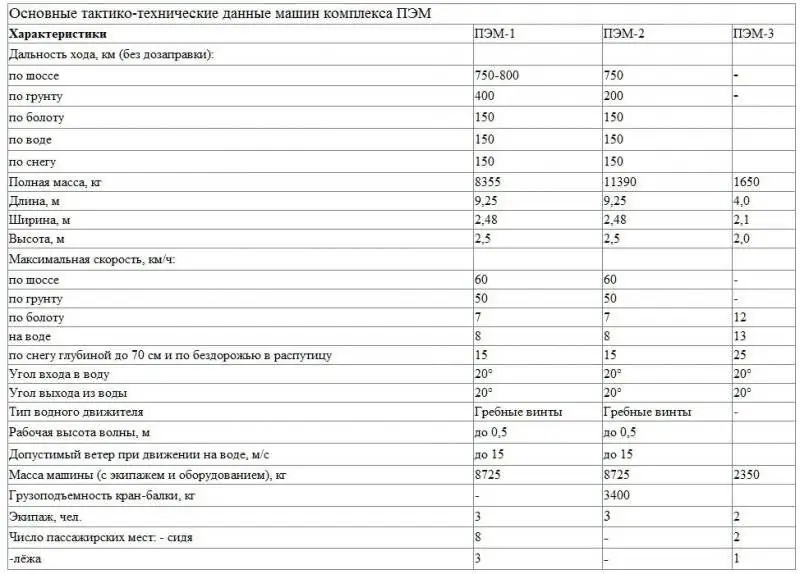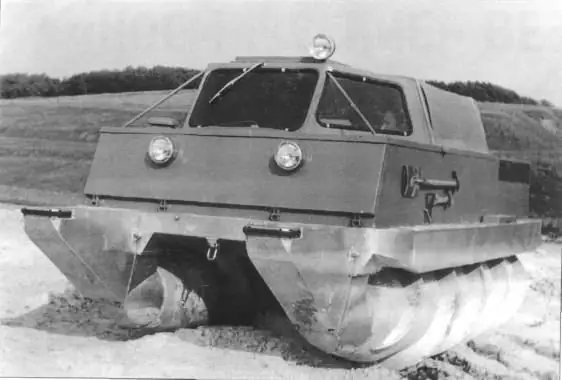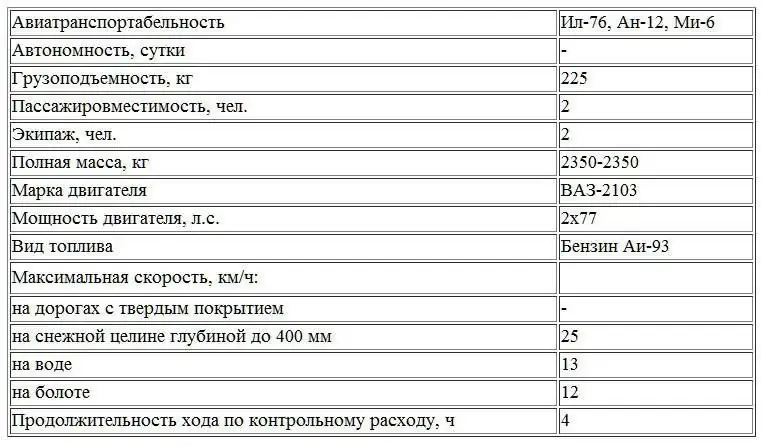- Author Matthew Elmers [email protected].
- Public 2023-12-16 21:49.
- Last modified 2025-01-24 09:17.
Since the beginning of space exploration, developers have had to solve the issue of returning astronauts from space to Earth, scientific, photographic, meteorological and other data. For these purposes, special descent vehicles were developed. Each device had its own size and shape, each had its own processes of those. service after landing, as well as other specific characteristics according to the tasks performed.

Also, for the delivery of descent vehicles to their destination, it becomes necessary to search and evacuate the vehicle already on Earth, since even at the current stage of technological development, it is possible to calculate the landing site only with a certain error. The error causes a number of poorly predictable factors, such as the wind speed at different altitudes during the descent or the accuracy of the engines switching on and their braking impulse. For manned vehicles of the "TMA" and "Soyuz-TM" type, the spread along the descent route can be up to 400 km, and the lateral deviation - up to 60 km. For example, Soyuz TMA-3 flew over the calculated landing point only 7 kilometers along the track, and Soyuz TMA-1 did not reach the calculated point of 440 km along the track with a right lateral deviation of 27 km. For unmanned descent vehicles, due to their low weight and dimensions, the deviation can be even greater. Also, the device can land on rough terrain, in a swamp, steppe and even splash down. In this regard, for search and evacuation, aviation, land and sea means are involved that perform search operations as part of a search complex or autonomously.
Mi-8 helicopters, An-12 or An-24 aircraft equipped with the appropriate equipment are used as aviation search means. For ground search of descent vehicles, search and recovery vehicles specially designed for this purpose are used - cross-country vehicles, as well as tracked vehicles and snowmobiles.

Preparation for the evacuation of the descent vehicle. In the background - FEM-1
This article will consider the varieties of ground search and rescue equipment - search and evacuation vehicles.
Search and recovery vehicles are designed to search and evacuate descent vehicles and their crews. The machines can perform assigned tasks autonomously or by interacting with search aircraft (helicopters). The search can be carried out in the steppe, wooded, desert, swampy areas, in the waters of inland water bodies or on virgin snow in different meteorological conditions and at different times of the day.
All search and recovery vehicles, by their weight and dimensions, are designed for transportation by various available modes of transport - from air to rail. For air delivery, the most commonly used Mi-6 helicopter and An-12 aircraft. It should be noted that each search and recovery vehicle has its own area of application and is designed for its own purposes.

The complex of search and evacuation vehicles (KPEM) is designed to search for descent vehicles of spacecraft in hard-to-reach steppe, swampy, wooded and desert areas, on virgin snow, in the waters of inland water bodies, as well as for the evacuation of astronauts, descent vehicles and capsules. The complex includes:
- search and evacuation passenger vehicle FEM-1;
- search and evacuation truck FEM-2;
- search and evacuation passenger vehicle (snow and swamp-going vehicle) FEM-3.
The FEM-1 and FEM-2 machines, which were created at the ZiL plant, are floating cross-country vehicles with a 6x6 wheel arrangement. The hulls of these search and recovery vehicles are made of polyester resin, which is reinforced with fiberglass. For the manufacture of the frame, aluminum alloy AMG-61 is used. Search and recovery vehicles can float over water obstacles, move on loose ground (immersion of wheels up to 50 cm), in snow (immersion of wheels up to 1 meter), swamp (immersion of wheels up to 70 cm). The cruising range in such conditions is up to 200 kilometers at a speed of 7 km / h (when passing through a swamp) to 40 km / h (when driving on solid ground).
The main areas of FEM-1 (2) application, taking into account these characteristics, are rugged steppe terrain with a small number of trees and a large number of various water obstacles. In this case, the main basing area can be located at a distance of 300 kilometers from the search site.
FEM-3 was made on special screw chassis from two longitudinally arranged multi-turn screws. Thanks to this, the speed of the car can reach 15 km / h in swamps and loose snow at a distance of up to 20 kilometers. However, this car cannot move on the ground or on the highway. In this regard, the main area of FEM-3 application is wetlands with shallow water barriers and snow cover reaching 1 meter. FEM-3 is delivered to the place of search by means of FEM-2 equipped with a crane-beam. The lifting capacity of the crane is 3.4 tons. It is used to lift the FEM-3 or the descent vehicle, which is laid in a special bed.
All types of search and recovery vehicles are used to carry out search operations. However, FEM-3 is used only in cases when it is impossible to search by FEM-1 and FEM-2 machines in the search areas. The evacuation of the crew is carried out, as a rule, on FEM-1, since it has a special passenger cabin for cosmonauts, and FEM-2 evacuates the descent vehicle.

To increase the efficiency of search operations, the machines are equipped with several systems: the navigation system "Kvadrat", an automatic radio compass ARK-UD, radio direction finders "Pelikan", NKPU-1 and KAR-1, as well as radio stations R-855UM, "Coral", "Zhuravl" and lighting equipment - a hand-held searchlight RSP-45 and a light-signal beacon OSS-61.
Radio communication equipment is used for two-way communication in telephone and telegraph modes inside the search complex and for communication with the control center. This type of equipment includes radio stations "Balkan-5", "Zhuravl-10", "Zhuravl-K", "Coral", R-802V, R-860, R-809M2, R-855UM, as well as a transceiver complex R-836 + RPS. The equipment operates in the MW, KB and VHF bands at a power of 0, 12 - 500 W. This allows you to have permanent reliable communication with control centers and aircraft at a distance of up to 100 kilometers in the VHF range and up to 600 kilometers in the HF range.
The short range of communication operating in the VHF range with the crew of the descent vehicles after landing is due to the small power of individual radio stations.
For direction finding of radio stations and radio beacons installed on descent vehicles, a special. equipment, which includes automatic radio compasses ARK-UD and ARK-U2, radio direction finders KAR-1, "Orel" and "Pelican" as well as portable direction finders NKPU-1. Direction finding is carried out at frequencies from 1.5 to 150 MHz. The HF direction finding range is about 25 kilometers, and the VHF range is 2 kilometers.
Navigation equipment is necessary for the exit of search and recovery vehicles to a given area and determine the location of the vehicle. The equipment includes a navigation system such as NVNT, "Kvadrat" and a magnetic compass KI-13. Recently, search engines are increasingly using the GPS system.

FEM-3 is a floating snow and swamp vehicle with rotary-screw propellers, which has a wheelhouse with a removable awning, designed to accommodate the crew and passengers. There are two seats for the FEM-3 crew, and two seats for passengers on a removable stretcher. FEM-3 buoyancy is ensured by a sealed supporting aluminum body and two screw rotors
Lighting equipment installed on search and recovery vehicles is designed to search for descent vehicles in poor visibility and adverse weather conditions, as well as to indicate the location of vehicles. Lighting equipment includes a hand-held searchlight RSP-45 with a detection range of descent vehicles up to 300 meters and an OSS-61 light signal beacon that emits red signals with a frequency of 1 Hz. The visual detection range of the beacon in simple weather conditions can be 25 kilometers.
In addition, the search and recovery vehicles are equipped with RM-5 radio beacons, the power of which is 80 W, and the operating frequency range is from 100 to 150 Hz. This equipment serves to facilitate the direction finding of vehicles using the ARK-UD radio compass by aviation search forces. With a flight altitude of 6 thousand m, the direction finding range is 100 kilometers.
The ground search complex, which includes FEM-1, FEM-2 and FEM-3, allows search and evacuation operations in various meteorological conditions and geographic zones, and with the help of special equipment, communicate with the crew of the descent vehicle, control points, ensure interaction and coordination search complex. The equipment makes it possible to quickly enter the search area and find the crew and the descent vehicle.

In 2004, the Rocket and Space Corporation Energia announced the development of a new reusable manned spacecraft Clipper, which was supposed to replace the Soyuz by 2010.
The Clipper is a reusable spacecraft that can deliver up to 700 kilograms of cargo and up to seven crew members into orbit. In addition, an autonomous spacecraft flight can take up to 10 days. In the event of an emergency on the ISS, Clipper evacuates the crew to Earth.
The launch mass of a spacecraft 10 meters long will be about 14.5 tons. It is assumed that the Russian launch vehicle Onega, which is a deeply modernized launch vehicle Soyuz, will be launched into Clipper orbit. The new spacecraft will be launched from all Russian cosmodromes equipped with Soyuz launch sites, that is, from Plesetsk and Baikonur.

The tactical and technical characteristics of the used search and recovery vehicles will not allow the evacuation of the descent vehicles, since their weight and size characteristics will change. Therefore, when designing and creating a new descent vehicle, it is necessary to resolve issues related to the provision of search and rescue forces with new means included in the search and rescue complex.
When developing advanced space technology, it is necessary to take into account the whole range of issues that arise in connection with its implementation and maintenance, since the FEM-2 is not adapted for the Clipper's weight and dimensions. The Mi-8 is not capable of transporting such a descent vehicle in the cargo hold or on an external sling. Consequently, the future complex must be transportable by helicopters and airplanes, which are in service with the PSK (Mi-6 and An-12BP). In addition, it should be equipped with modern standard navigation equipment (ARC and 10R-26). The driving performance of the complex should not be inferior to the existing one. The number of passenger seats in the box body must be increased to 8-10 people, and the power reserve must be at least 1000 km. The astronauts must be transported to the helicopter in a prone position; the machines must be equipped with self-recovery winches.
In connection with the development of new descent vehicles, it is necessary to expect a new stage in the development of search and recovery vehicles. The advancement of one branch of rocket and space technology is the reason for the need to pull up to its level the entire complex of ground support, including search and rescue.






